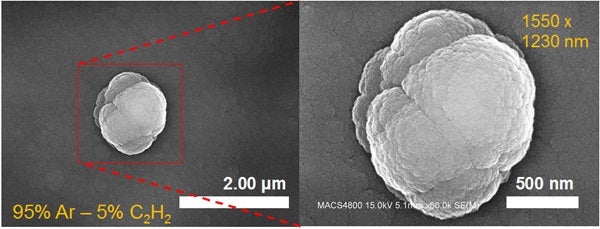Using a specialized facility, called the Cosmic Simulation Chamber (COSmIC) designed and built at Ames, scientists now are able to recreate and study in the laboratory dust grains similar to the grains that form in the outer layers of dying stars. Scientists plan to use the dust to gather clues to better understand the composition and the evolution of the universe.
Dust grains that form around dying stars and are ejected into the interstellar medium, after a life cycle spanning millions of years, lead to the formation of planets and are a key component of the universe’s evolution. Scientists have found the materials that make up the building blocks of the universe are much more complicated than originally anticipated.
“The harsh conditions of space are extremely difficult to reproduce in the laboratory and have long hindered efforts to interpret and analyze observations from space,” said Farid Salama from Ames Research Center. “Using the COSmIC simulator, we can now discover clues to questions about the composition and the evolution of the universe, both major objectives of NASA’s space research program.”
In the past, the inability to simulate space conditions in the gaseous state prevented scientists from identifying unknown matter. Because conditions in space are vastly different from conditions on Earth, it is challenging to identify extraterrestrial materials. Thanks to COSmIC, researchers can successfully simulate gas-phase environments similar to interstellar clouds, stellar envelopes, or planetary atmosphere by expanding gases using a cold jet spray of argon gas seeded with hydrocarbons that cools down the molecules to temperatures representative of these environments.
COSmIC integrates a variety of state-of-the-art instruments to allow scientists to recreate space conditions in the laboratory to form, process, and monitor simulated planetary and interstellar materials. The chamber is the heart of the system. It recreates the extreme conditions that reign in space where interstellar molecules and ions float in a vacuum at densities that are billionths of Earth’s atmosphere; average temperatures can be less than –270° Fahrenheit (–170° Celsius), and the environment is bathed in ultraviolet and visible radiation emanating from nearby stars.
“By using COSmIC and building upon the work we recently published in The Astrophysical Journal August 29, 2013, we now can for the first time truly recreate and visualize in the laboratory the formation of carbon grains in the envelope of stars and learn about the formation, structure, and size distribution of stellar dust grains,” said Cesar Contreras of the Bay Area Environmental Research (BAER) Institute. “This type of new research truly pushes the frontiers of science toward new horizons and illustrates NASA’s important contribution to science.”
The team started with small hydrocarbon molecules that it expanded in the cold jet spray in COSmIC and exposed to high energy in an electric discharge. They detected and characterized the large molecules that are formed in the gas phase from these precursor molecules with highly sensitive detectors, and then collected the individual solid grains formed from these complex molecules and imaged them using Ames’ Scanning Electron Microscope (SEM).
“During COSmIC experiments, we are able to form and detect nanoparticles on the order of 10-nanometer size, grains ranging from 100 to 500 nanometers and aggregates of grains up to 1.5 micrometers in diameter, about a tenth the width of a human hair, and observe their structure with SEM, thus sampling a large size distribution of the grains produced,” said Ella Sciamma-O’Brien of the BAER Institute.
These results have important implications and ramifications not only for interstellar astrophysics, but also for planetary science. For example, they can provide new clues on the type of grains present in the dust around stars. That in turn will help astronomers understand the formation of planets, including Earth-like planets. They also will help interpret astronomical data from the Herschel Space Observatory, the Stratospheric Observatory for Infrared Astronomy (SOFIA), and the ground-based Atacama Large Millimeter/submillimeter Array observatory in Chile.
“Today, we are celebrating a major milestone in our understanding of the formation and the nature of cosmic dust grains that bears important implications in this new era of exoplanets discoveries,” said Salama.










